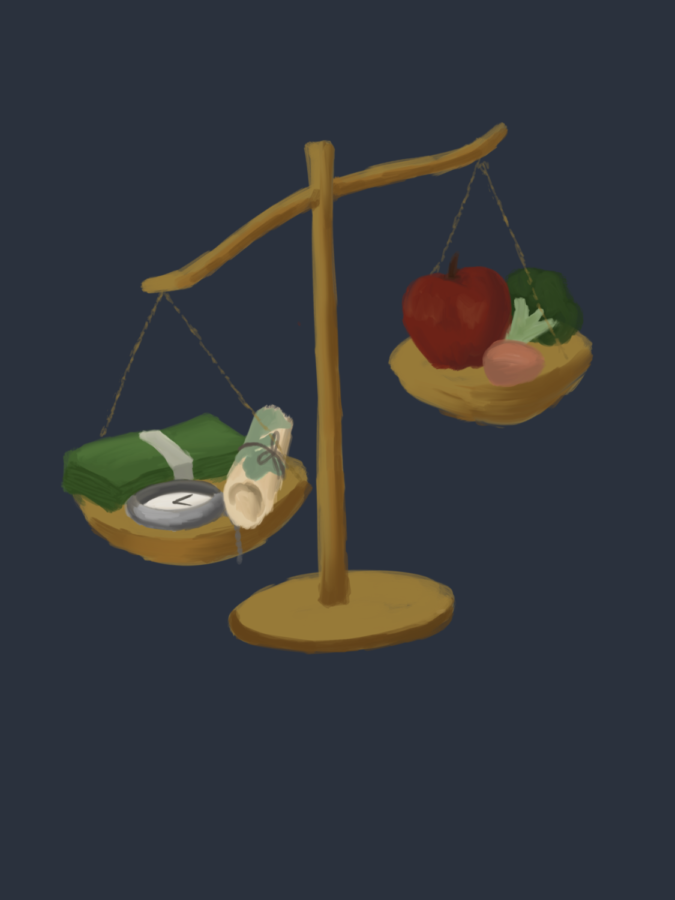The wealthier, the healthier; how socioeconomic status affects eating habits
In the modern world, there are many ways to access food. From high-end restaurants to Walmarts, the range of options can seem virtually limitless to some. But there are many limiting factors that influence each individual’s food choices, such as wealth, location and time. Around the globe, people have many different dietary habits, but what are Evanstonians eating, and why?
Although Evanston isn’t as geographically large or populated as Chicago, there are still distinctive ‘food districts.’ Downtown Evanston has lots of restaurant options to accommodate the larger concentration of residents, but other, more residential areas have limited options. While people can drive to other places to eat and shop for groceries, more often than not, they buy from establishments closer to their home. That, in turn, can affect their entire dietary lifestyle.
A major influence on dietary choices stems from economic factors. While it is well known that in general, wealthier people can afford to eat higher quality food, there are a lot of nuances that generally go unnoticed.
In recent years, many people have converted from omnivore diets to either vegetarian or vegan ones. According to GlobalData, between 2014 and 2017, the number of vegans in the U.S. grew by 600 percent. While veganism is great for the environment and has many health benefits, there are some real barriers for those trying to go vegan on a low budget. For example, alternatives to meat for vegans that have become recently popular, like Impossible and Beyond Meat, are quite expensive compared to their beef counterparts, making them less accessible. Pound for pound, regular beef is 43 percent less expensive than its non-meat alternatives, which is a significant cost increase to swallow when making your rounds at the grocery store.
Additionally, studies have shown that vegans have to spend 65 percent more on an average meal than someone without any dietary restrictions. If you have to spend a significantly larger amount of money each time you go out to eat when vegan, it becomes a luxury reserved for the wealthy, who can afford to spend that extra money. That is why grocery stores and restaurants that cater to people with vegan and vegetarian diets are found in wealthier neighborhoods, since that is where their main customer base comes from. All these factors, while not intentionally limiting access to diets such as veganism, all contribute to the exclusivity of these dietary habits.
It is true that vegan diets cost more than non-vegan diets, but we can classify the trend more generally by saying that eating healthy foods costs a significant amount more than less healthy options. This stems from the fact that manufacturers can produce processed, unhealthy food options at a much lower cost than naturally grown, nutritious options.
In an interview with The Telegraph, Anna Taylor, the executive director of the Food Foundation, speaks to this divide. “Unhealthy food is so cheap because the prime ingredients can be mass produced and these products can be created in a non-perishable form. We have this situation where it is very easy to buy very cheap calories with very low levels of nutrients. Whereas the same is not true for some of the more nutrient-rich foods like fruits and vegetables.” Taylor says “If you have a lot of money, you can kind of buy your way out of the problem. If you don’t have a lot of money, you’re stuck with that really toxic combination of having not much money combined with the unhealthy food environment that we already have, which is leading to some of those really worrying health outcomes.”
Anyone can make the choice to eat unhealthy food, but not everyone can make the choice to eat healthy food. This is why people with a higher socioeconomic status are more likely to choose healthier food options, because they at least have a choice. This point is reflected in data showing obesity rates among people who live in the U.S.
According to a study on the socioeconomics of obesity, “Persistent household food insecurity, in particular when present without hunger, has been associated with a 22 percent increased odds of childhood obesity versus children who are food secure throughout childhood. Adults with food insecurity similarly have a higher prevalence of obesity compared to adults who are food secure.”
Socioeconomic status affects the diets of adults, but it also influences those of their children. Studies have shown that wealthier people can afford to feed their children healthier foods, like vegetables, without worrying about whether the child will waste it or not. Children who are exposed to nutritious foods early in life are more likely to choose healthier options in adulthood, which shows that socioeconomic status affects eating habits even throughout multiple generations.
An example of someone who was encouraged to eat healthily from childhood is Corinne Perez, a junior at ETHS and someone who lives in the same area as the high school.
“My mom always encouraged healthy eating habits,” Perez says. “We never really grew up with soda around the house. We would have a lot of healthy options and a lot of vegetables.”
When planning what to eat for the week, many people start by going to their local grocery store over the weekend. Most grocery stores have many options, but some are healthier than others. Whole Foods Market, where it is more strugglesome to find highly processed foods than somewhere like Walmart, is rated as one of the healthiest grocery stores in the United States. According to Business Insider, the average income of the people that shop there is $80,000. Compared to the median income in the United States, which is about $30,000, it is evident that some healthy grocery stores, like Whole Foods, are a resource that only the wealthier can afford.
“We usually shop at Whole Foods, Trader Joe’s, and Jewel-Osco,” sophomore and North Evanston resident Anthony LaRosa said. “We go to Whole Foods and Trader Joe’s if we want healthy food, but if we want more snack-like stuff, we go to Jewel, because the other places don’t have very much junk food.”
Sophomore and South Evanston resident Annie Gertz sees Jewel-Osco in a similar way. “We go to Jewel-Osco because it’s really close by and it’s kind of cheap, but it’s not that healthy. We usually have more quantity than quality.”
Perez’s family usually shops at Trader Joe’s and Valli Produce, and she agreed that one can find healthy foods to eat there if that is their goal.
Overall, wealthier people have the option to eat healthier and follow more diets than people of lower socioeconomic status and that often reflects in their overall health. It is still possible for people with lower food budgets to eat and shop healthy at their local grocery stores and restaurants, but the greater amount of money required to do so often outweighs the benefits.
Entire neighborhoods without so much as a corner store, blocks and blocks of residential homes and not a grocery store in sight. These are Evanston’s food deserts. According to the USDA, food deserts are areas where people have limited access to a variety of healthy foods, and there are plenty in Evanston. In areas such as the Fifth Ward, it’s near impossible to get groceries without driving, especially if you don’t want to pay the premium for front-door delivery. Even around Northwestern, an area which features some of Evanston’s preeminent restaurants, it’s not always easy to access healthy food.
Northwestern Senior Beni Keown explains, “The only real grocery store within walking distance of campus is a Whole Foods, so if you want normal, cheap groceries you need to take a bus or a car.”
The National Library of Medicine reports that placing food further away from people decreases likelihood of consumption, which makes food deserts especially devastating. This is also detrimental when close, healthy, options are scarce.
“Restaurants near the college are still pretty expensive. Most of the restaurants are catering to college students, so it’s a lot of fried meat and cheese,” Keown says.
It’s clear that a lack of accessible, affordable and healthy food options is present in Evanston. But it isn’t just Evanston. Over 6,500 food deserts still exist in the U.S., and they disproportionately exist in areas with high poverty rates. Food deserts exist in almost every major urban center in America, and lack of transportation options can leave families without access to the most basic human need: healthy food.
The proximity one has to grocery stores and restaurants is crucial to the availability of affordable and healthy food. As Gertz explained, one of the main reasons her family shops at Jewel-Osco is how close it is to them. Two of the restaurants Perez usually would go to were Dengeos or Paninos, both in close proximity to where she lived. When LaRosa’s family eats out, one of their standard restaurants is Bluestone, which is just around the corner from his home. LaRosa doesn’t think the food there is particularly healthy, but the convenience and easy walking distance play a part in why they go there a lot.
“I wouldn’t say it’s health focused. It’s fine, I guess,” said LaRosa. “You can get a salad, but the main things people get there probably aren’t great.”
It is impractical and sometimes impossible for someone with no car and no access to public transportation to get food if they live in a food desert. The other options are biking or walking, but this can sometimes mean making an exhausting journey traveling miles just to get a bite to eat. You might say that Evanston is connected to one of the best public transportation systems in the country, so our residents don’t experience these tribulations. But our El stations are few and far between, and most communities in food deserts are actually miles away from the nearest train station. And when it comes to buses, the inconsistency of arrival times and restricted access bus routes give good dining options nullified efficiency. And even if perfect public transportation existed in food deserts, they’d still have to pay the fare and haul groceries halfway across town. Access to healthy and affordable food is a crucial human right, and a tenant of a prospering society, but we have consistently failed to provide adequate aid to struggling communities.
When it comes to food, something perhaps just as pressing as proximity or wealth is the ultimate resource: time. The average adult works more than eight hours a day, which leaves not a lot of time to cook an elaborate, healthy meal for an entire family.
According to the National Library of Medicine, “The most frequently reported barrier to healthful eating is lack of time, with young adults citing challenges in balancing work, school, and leisure schedules.”
Time constraints have a significant impact on one’s diet, and when meal prep takes hours out of your day, it can eat into time which could be spent working or relaxing after a long day. It’s for these reasons that more than one third of surveyed adults reported that they were too busy to eat healthy foods, and over 71 percent said they ate fast food at least once a week. The clear trend is that people working 9-5 jobs simply don’t have the time to eat healthily, turning instead to cheaper and faster options like fast food or microwavable meals. The downside is that these often have far less nutritional value.
Additionally, it has been shown that it is important for families to eat at least one meal a day together. This results in better mental health and healthier eating habits, among other things. The only issue is that a lot of families don’t have the time to devote to dining together, and can miss out on the many benefits of doing so.
Growing up, LaRosa’s family made it a priority to cook healthy meals at home and to eat together.
“We usually would have healthy ingredients in the house, and that’s what we would eat for dinner most of the time. Usually, we’d have homemade dinners pretty much every night, except maybe once a week when we’d go out,” LaRosa says. “Usually, we eat together at night. There are some instances where it is less organized, like when someone is coming home from a trip, but usually we eat together.”
The lack of time restricting one’s diet is also incredibly prevalent in colleges, with Temple News reporting that their students sometimes skip meals entirely to make time for their workload. With classes, jobs, and mountains of homework, most college students can’t make time to cook a full meal. Aside from not having the time, a lot of students don’t have the skills to make a quality meal for themselves. SWNS reports that one in five polled college grads never learned to cook and that a lack of knowledge combined with financial restraints led to some very unhealthy eating habits. For a lot of students, their work is the biggest priority, so personal wellness and healthy dietary habits often get sidelined in favor of bare minimum fast food options. Above all, cooking healthy meals takes time. And that’s something that a lot of people just can’t spare.
When looking at the three main factors that seem to influence a person’s dietary habits, it is essential to bring up the point that these factors often go together. People who live in generally wealthier areas tend to live closer to healthier options or more diet focused options, and wealthier people generally have more time to spare to spend on cooking. It is no coincidence that a lot of vegan restaurants, like Spirit Elephant in Winnetka, are found in some of the areas with the highest annual household incomes in the country. On the contrary, food deserts disproportionately affect lower income families, which makes it a long and arduous process to gain access to healthy food. Overall, socioeconomic status, time and location, while each contributing to dietary habits in their own way, are often correlated with one another.
So what can you do to maintain healthy eating habits under challenging circumstances? If you’re a student, the answer is pretty simple: eat cafeteria food. While not exactly five-star quality, the CDC found that students who participate in school meal programs consume more whole grains, milk, fruits and vegetables and have better overall dietary habits than non-participants. And in the United States, you can always apply for food stamps in your state if you come from an economically challenged household.
In Evanston, and around the world, it is essential to eat healthy foods to maintain a healthy lifestyle. Unfortunately, that is not often a possibility for many people, and other, more pertinent aspects of life generally take priority over what to eat for dinner. In reality, what people eat in Evanston depends much more on the three factors brought up in this article than anything to do with the fact that they live in Evanston. Many people think of healthy eating as a choice, and while it is in certain scenarios, that’s just not the case for many people in our town, our country and our world.
Your donation will support the student journalists of the Evanstonian. We are planning a big trip to the Journalism Educators Association conference in Philadelphia in November 2023, and any support will go towards making that trip a reality. Contributions will appear as a charge from SNOSite. Donations are NOT tax-deductible.

















